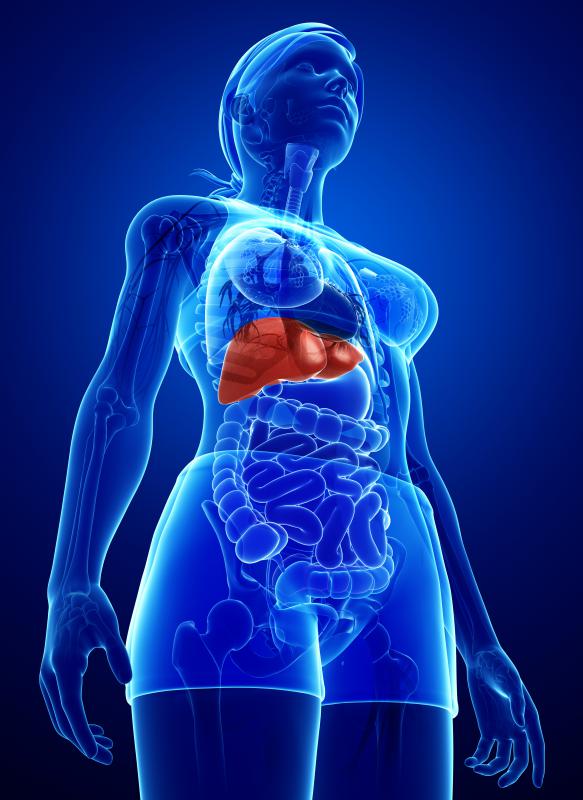At AllThingsNature, we're committed to delivering accurate, trustworthy information. Our expert-authored content is rigorously fact-checked and sourced from credible authorities. Discover how we uphold the highest standards in providing you with reliable knowledge.
What is a Peroxisome?
A peroxisome is a specialized structure inside a cell which helps to rid the body of the host organism of toxins. In animals, peroxisomes are often especially concentrated in the neighborhood of the liver and kidneys, the filtration centers for toxins. In plants, peroxisomes assist with photosynthesis. In either instance, a peroxisome disorder can be a serious problem, as these structures are crucial to the wellbeing of much of life on Earth.
Like other specialized structures inside a cell, a peroxisome is considered to be an example of an organelle. Essentially, organelles are like miniature organs inside the cell, just as their name suggests, and they perform many of the same functions that major organs do, only on a much smaller scale. When viewed under a microscope, it is possible to see that peroxisomes are roughly spherical in shape, and they are surrounded by an envelope of lipids and proteins which protects the rest of the cell from the activity inside the peroxisome.

These structures were first firmly identified in 1967, a decade after they had been described by a Swedish doctoral student. The peroxisome is rather a unique organelle, because it is capable of replicating itself, much like DNA. When more peroxisomes are needed in a cell, the existing peroxisomes can grow and then split themselves to meet the need.

When a peroxisome absorbs a toxin, it oxidizes it, converting it to hydrogen peroxide. However, hydrogen peroxide isn't a very healthy thing to have floating around in the body in large amounts, so peroxisomes are also capable of breaking down hydrogen peroxide, turning it into useful water and oxygen which can be utilized by the cell for a variety of tasks or expressed, if the body has an excess.

Peroxisomes are part of the process of cell metabolism, which keeps cells running smoothly to ensure that they have enough energy to perform their functions. With peroxisomes on the fritz, people can develop disorders related to a buildup of lipids and other toxins in their bodies. This can manifest in the form of a variety of conditions, including the neurological disorder known as Zellweger Syndrome.
Frequently Asked Questions
What is a peroxisome and what is its primary function in the cell?
A peroxisome is a small, membrane-bound organelle found in virtually all eukaryotic cells. Its primary function is to sequester and break down toxic peroxides, such as hydrogen peroxide, through oxidative reactions. This detoxification process is crucial for cell protection and metabolism, including the breakdown of fatty acids.
How do peroxisomes differ from other organelles like mitochondria?
Peroxisomes differ from mitochondria in both structure and function. While mitochondria are larger and have their own DNA, peroxisomes do not contain DNA and are solely dependent on the cell's nucleus for their encoded proteins. Functionally, mitochondria are the cell's powerhouse, generating ATP through respiration, whereas peroxisomes focus on catabolizing fatty acids and detoxifying harmful substances.
Can peroxisomes be linked to any human diseases?
Yes, peroxisomes are linked to several genetic disorders, collectively known as peroxisomal disorders. These include Zellweger syndrome, adrenoleukodystrophy, and Refsum disease. These conditions arise from mutations affecting peroxisome biogenesis or enzyme deficiencies within peroxisomes, leading to the accumulation of toxic substances and widespread cellular dysfunction.
What role do peroxisomes play in lipid metabolism?
Peroxisomes play a critical role in lipid metabolism, particularly in the beta-oxidation of very-long-chain fatty acids. Unlike mitochondria, which handle shorter-chain fatty acids, peroxisomes break down the longer chains into medium-chain fatty acids, which mitochondria can then further process for energy production.
How are peroxisomes formed within the cell?
Peroxisomes are formed through both the growth and division of existing peroxisomes and the de novo synthesis from the endoplasmic reticulum. Proteins necessary for peroxisome function are synthesized in the cytoplasm and imported into the peroxisome via specific signaling sequences recognized by peroxisomal membrane receptors.
Do peroxisomes have any role in responding to oxidative stress?
Yes, peroxisomes are integral in the cellular response to oxidative stress. They contain enzymes like catalase, which neutralize harmful reactive oxygen species (ROS) by converting hydrogen peroxide into water and oxygen. This function is essential for maintaining cellular redox balance and preventing oxidative damage to biomolecules.
AS FEATURED ON:
AS FEATURED ON:













Discussion Comments
I read somewhere that peroxisomes are distributed throughout the cell. Is that true?
They are located along with the lysosomes in the cytoplasm. They are usually present near the golgi apparatus.
Where is the peroxisome located in the cell?
how does proxisome perform inside the cell?
what do peroxisomes do in a euglena?
Post your comments